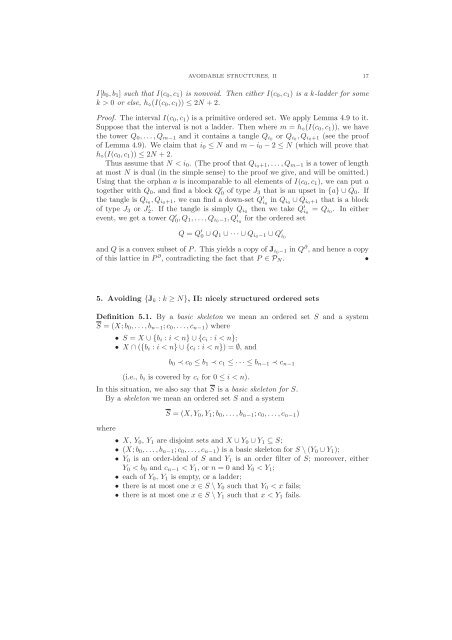Avoidable structures, II: finite distributive lattices and nicely ...
Avoidable structures, II: finite distributive lattices and nicely ...
Avoidable structures, II: finite distributive lattices and nicely ...
Create successful ePaper yourself
Turn your PDF publications into a flip-book with our unique Google optimized e-Paper software.
AVOIDABLE STRUCTURES, <strong>II</strong> 17<br />
I[b 0 ,b 1 ] such that I(c 0 ,c 1 ) is nonvoid. Then either I(c 0 ,c 1 ) is a k-ladder for some<br />
k > 0 or else, h ⋄ (I(c 0 ,c 1 )) ≤ 2N +2.<br />
Proof. The interval I(c 0 ,c 1 ) is a primitive ordered set. We apply Lemma 4.9 to it.<br />
Suppose that the interval is not a ladder. Then where m = h ⋄ (I(c 0 ,c 1 )), we have<br />
the tower Q 0 ,...,Q m−1 <strong>and</strong> it contains a tangle Q i0 or Q i0 ,Q i0+1 (see the proof<br />
of Lemma 4.9). We claim that i 0 ≤ N <strong>and</strong> m−i 0 −2 ≤ N (which will prove that<br />
h ⋄ (I(c 0 ,c 1 )) ≤ 2N +2.<br />
Thus assume that N < i 0 . (The proof that Q i0+1,...,Q m−1 is a tower of length<br />
at most N is dual (in the simple sense) to the proof we give, <strong>and</strong> will be omitted.)<br />
Using that the orphan a is incomparable to all elements of I(c 0 ,c 1 ), we can put a<br />
together with Q 0 , <strong>and</strong> find a block Q ′ 0 of type J 3 that is an upset in {a}∪Q 0 . If<br />
the tangle is Q i0 ,Q i0+1, we can find a down-set Q ′ i 0<br />
in Q i0 ∪Q i0+1 that is a block<br />
of type J 3 or J ′ 2. If the tangle is simply Q i0 then we take Q ′ i 0<br />
= Q i0 . In either<br />
event, we get a tower Q ′ 0,Q 1 ,...,Q i0−1,Q ′ i 0<br />
for the ordered set<br />
Q = Q ′ 0 ∪Q 1 ∪···∪Q i0−1 ∪Q ′ i 0<br />
<strong>and</strong> Q is a convex subset of P. This yields a copy of J i0−1 in Q ∂ , <strong>and</strong> hence a copy<br />
of this lattice in P ∂ , contradicting the fact that P ∈ P N .<br />
•<br />
5. Avoiding {J k : k ≥ N}, <strong>II</strong>: <strong>nicely</strong> structured ordered sets<br />
Definition 5.1. By a basic skeleton we mean an ordered set S <strong>and</strong> a system<br />
S = (X;b 0 ,...,b n−1 ;c 0 ,...,c n−1 ) where<br />
• S = X ∪{b i : i < n}∪{c i : i < n};<br />
• X ∩({b i : i < n}∪{c i : i < n}) = ∅, <strong>and</strong><br />
b 0 ≺ c 0 ≤ b 1 ≺ c 1 ≤ ··· ≤ b n−1 ≺ c n−1<br />
(i.e., b i is covered by c i for 0 ≤ i < n).<br />
In this situation, we also say that S is a basic skeleton for S.<br />
By a skeleton we mean an ordered set S <strong>and</strong> a system<br />
where<br />
S = (X,Y 0 ,Y 1 ;b 0 ,...,b n−1 ;c 0 ,...,c n−1 )<br />
• X, Y 0 , Y 1 are disjoint sets <strong>and</strong> X ∪Y 0 ∪Y 1 ⊆ S;<br />
• (X;b 0 ,...,b n−1 ;c 0 ,...,c n−1 ) is a basic skeleton for S \(Y 0 ∪Y 1 );<br />
• Y 0 is an order-ideal of S <strong>and</strong> Y 1 is an order filter of S; moreover, either<br />
Y 0 < b 0 <strong>and</strong> c n−1 < Y 1 , or n = 0 <strong>and</strong> Y 0 < Y 1 ;<br />
• each of Y 0 , Y 1 is empty, or a ladder;<br />
• there is at most one x ∈ S \Y 0 such that Y 0 < x fails;<br />
• there is at most one x ∈ S \Y 1 such that x < Y 1 fails.
















